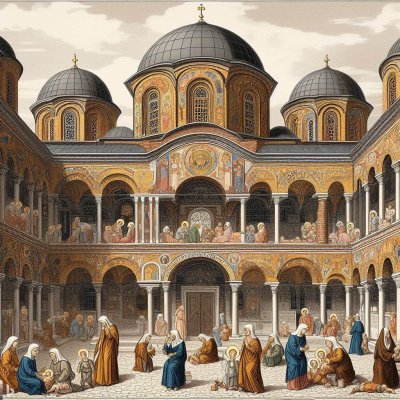Constantinople was famous for many things, one of which was “its many philanthropic institutions – hospitals, old-age homes, asylums for the poor — facilities that the city zealously supported.” These were “essential elements of the capital’s urban life.”

“By 550 Constantinople had acquired many social welfare institutions, supported by bishops, monastic leaders, wealthy laymen, and the imperial government, facilities which sources describe with new terms, which are important to define.”
“Orphanotropheion identified a group home for orphans. In Constantinople, the oldest and most prestigious philanthropic institution was the Great Orphanotropheion, located on the city’s citadel overlooking the Bosporos. In addition to this central facility, many monasteries maintained small orphanotropheia.”
“Etymologically, ptochotropheion or ptocheion meant an institution to feed and house the poor, but before the tenth century sources universally used these terms to designate leprosaria. Eustathios, bishop of Sabasteia, and Basil of Caesarea called the leprosaria they opened in Asia Minor ptochotropheia. In his sermon condemning Christians’ disdain for lepers, Gregory of Nazianzos referred to lepers as the poorest of the poor because they had lost the capacity to help themselves.”

“Nosokomeion designated a place to treat people suffering from diseases, and by 400 the staff of such institutions usually included salaried physicians. Thus, nosokomeion may be translated as a hospital for the sick. A more difficult term, often replacing nosokomeion in popular use, was xenon. The sixth-century historian Prokopios used xenon in its classical meaning – a guest house or hospice for visitors. A less classicizing text of the same century, the Miracles of Kosmas and Damian, however, selected xenon to identify an institution with surgeons, operating room, and a locked storage cabinet for medicines.”

“Gerokomeia were originally founded as asylums for the aged. According to urban tradition in Constantinople, several aristocrats opened such homes during the fifth century. Soon, however, gerokomeia began to accept patients who suffered from chronic diseases.”
“Finally, diakoniai differed from all other philanthropic facilities. They were founded by sixth-century Monophysite communities to offer charitable assistance to their own flock so that believers did not have to seek help from Calcedonians. After the defeat of the Monophysite movement in Constantinople in 565, these diakoniai were taken over by the Orthodox church. As they evolved, they focused on providing free baths for the poor. They played a key role in transferring Constantinople’s bathing practices from the monumental Greco-Roman bath houses with open pools to modest hamams where bathers washed in small tubs in semiprivate alcoves.”
“Constantinople’s social welfare institutions were extraordinary for the range of their services: homes for orphans, lepers, and the poor; free baths at the diakoniai; food provided in emergencies; and medical care for acute and chronic diseases. In Constantinople, however, the wealthy also planned to use these institutions if they or their close relatives had need of their services. For this reason we can be reasonably certain that no one in a Byzantine hospital had to share a bed with one or two other patients as occasionally happened at the Hôtel Dieu in Paris, nor did orphans in Constantinople receive only training in artisanal crafts. Indeed, the twelfth-century Orphanotropheion hired leading intellectuals of the empire for its students.”
“Because both rich and poor benefitted from the” many institutions – “the quality of service was better than in the West. Byzantine writers – Gregory of Cyprus, Andronikos Kallistos, and others – viewed these institutions as unique to Constantinople, almost as impressive as the city’s famous walls and the great dome of Hagia Sophia.”
Source:
The Cambridge Companion to Constantinople – Chapter 15 by Timothy S. Miller

